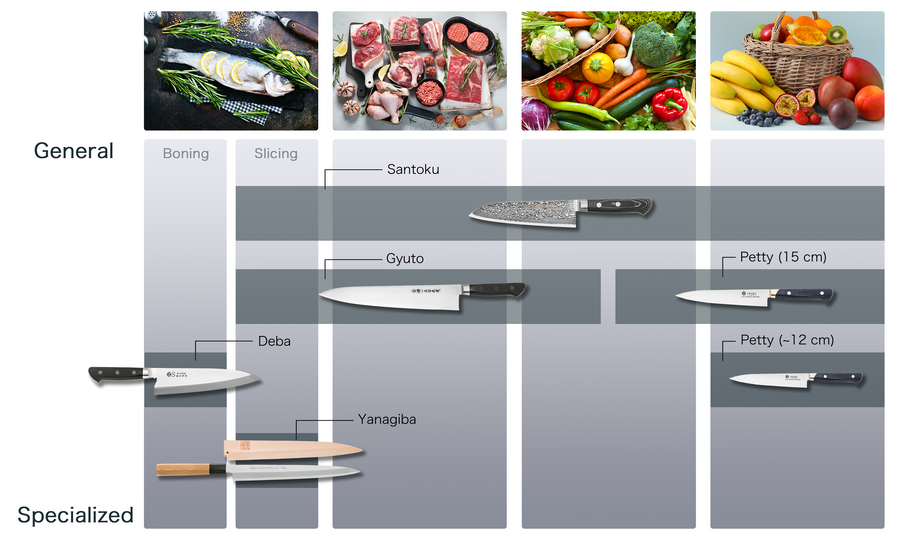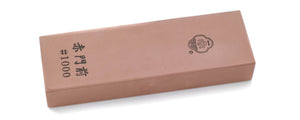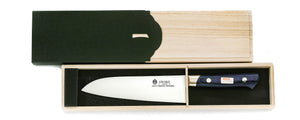Deba Knives: Japanese Fish Filleting Knives

The quintessential Japanese kitchen knife, the deba knife has been made in Sakai for hundreds of years and is perfect for filleting fish. Sakai Ichimonji Mitsuhide, a trusted knife vendor in Osaka has supported the Sakai knifemaking scene for over 70 years, and can now bring these artisinal deba knives directly to your door.
What is a Deba Knife used for?
A deba knife is a traditional Japanese knife, commonly used for filleting fish. The blade is thick and heavy in comparison to most Japanese kitchen knives.
Its primary role is to cut through fish, while also slicing through soft flesh with the knife's sharp and refined tip. A Deba knife can also be used to crack through the shells of crabs or other seafood, using the heel of the blade.
How big are Deba Knives ?
Deba Knives range from 100mm to 240mm in blade length. Different blade lengths offer different benefits. They generally come in 15mm increments.
For example, a short Deba knife is easy to handle, making it ideal for slicing fish and small bones. In turn, this is difficult to use for heavier tasks like trying to cut through fish heads.
Alternatively a longer Deba knife gives you additional weight to remove fish heads more easily, though your hands will tire quicker.
Sometimes people will choose to own multiple Deba of varying size differences, but choose what is best for you.
How to Choose a Deba Knife
For home use, people generally choose a Deba knife between 150mm - 165mm in length. We recommend Deba Knives of 180mm - 195mm for people who deal with sea bream, yellowtail or other larger fish.
Japanese chefs usually use two Deba Knives, a small one around 150mm and a larger 210mm version.
Compared to sashimi knives like yanagiba knives, a Deba Knife is more useful for preparation work. Deba Knife owners must consistently and evenly sharpen their knives from rear to tip to cut cleanly through fish without damaging the flesh.
Carbon Steel or Stainless Steel?
Carbon Steel is easy to sharpen, holds the best edge and cuts with ease. This steel is susceptible to rust though, so it requires more maintenance and care.
Stainless Steel is rust resistant and easier to maintain, but cannot match Carbon Steel's sharpness despite recent improvements. Stainless Steel Knives are also more difficult to sharpen than Carbon Steel, requiring more patience.
Our Recommended Deba Knives?
Most Sakai Ichimonji Deba Knives are forged from a billet of steel and hammered into shape and we suggest you aim for a forged blade rather than stamped. Deba can take an exceptional beating if used for boning so a forged blade offers the best performance.
For Japanese & Sushi Restaurant Knives: We recommend the Ichimonji White Steel #1 (Shirogami 1) Montanren Deba Knife. This our most popular Deba knife and is strong enough to withstand repeated use chopping through fish heads.
Note the White Steel #1 (Shirogami 1) is a High Carbon Steel and requires careful maintenance to prevent rust.
For Chefs who do not have the time for the maintenance that comes with Carbon Steel: We recommend the Ichimonji Kasumi Deba made of Silver Steel #3 (Ginsan). This is a high quality, Japanese Style Kitchen Knife with excellent edge retention.
For people who prefer a Western Style Handle: We suggest the G-Line VG-1 Deba Knife with compressed plywood handle. VG-1 Stainless Steel is so hard that is quite difficult to sharpen but it will hold its edge for longer.

How to Choose a Japanese Kitchen Knife for Beginners
Japanese kitchen knives are famous for their design, history, and cutting performance. This guide will help you select the best knife for your needs.


































